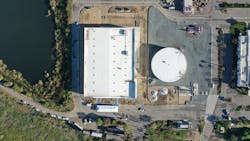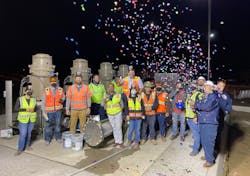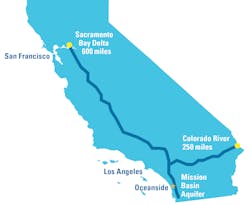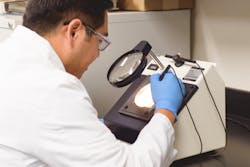Advanced purified water first flowed from Pure Water Oceanside on Dec. 30, 2021, making the site the first operational indirect potable reuse (IPR) facility in San Diego County, Calif. The project treats the City of Oceanside’s wastewater flows and, after additional residence time in the ground and further treatment, will distribute the finished purified drinking water to city customers later this summer.
The $71 million project took eight years of planning and two years of construction during the height of the coronavirus pandemic. The facility is able to produce anywhere from 3 to 4.5 million gallons daily (MGD). Through the implementation of Pure Water Oceanside, the city is able receive over 30 percent of its water supply from the local groundwater basin.
In 2009, the Oceanside City Council set a goal of a 50 percent local water supply by 2030. During the next several years, the city contemplated several locally-sourced water supply options, including ocean desalination and IPR. The ambitious 2009 goal would decrease the city’s dependence on imported water at a time when this source accounted for 89 percent of Oceanside’s water supply.Reasons for Reuse
Before the project began, Oceanside’s imported water traveled hundreds of miles away from the Colorado River and the Bay Delta located in Northern California. This imported water is subject to rising costs not under the city’s control, requires an enormous amount of energy to transport, and is vulnerable to natural disasters like earthquakes — with so much reoccurring drought in California, importing would be unsustainable.
Furthermore, diverting water from the Colorado River and Bay Delta affects the sensitive ecosystems on which fish and other wildlife depend, providing another reason to create a reliable source of water to the area.
The city is fortunate to have a naturally occurring underground aquifer, called the Mission Basin. Historically, this underground aquifer has supplied the city with between 10 and 15 percent of local potable water.
However, the amount of water stored within the aquifer and its quality began decreasing from years of use and drought. The water pulled from the aquifer is treated at the city’s Mission Basin Groundwater Purification Facility through reverse osmosis (RO) to treat the brackish groundwater, reducing salt concentrations. Additional treatment removes iron and manganese.
In close proximity to the groundwater treatment plant is another city-operated facility, the San Luis Rey Water Reclamation Facility, which treats wastewater to the secondary level with conventional biological treatment followed by clarification. This plant sends treated wastewater through additional filtration and disinfection, which allows the water to be used to irrigate golf courses, parks, and street landscaping. Additional plant discharges are released to the Pacific Ocean.
The city also uses energy from a solar farm and a cogeneration facility located at the same wastewater treatment facility site. The energy helps to offset the daily energy demand needs for facility operations. A future planned project will also introduce food scraps into a wastewater digester to bolster biogas production and optimize cogeneration operations.
Bringing the Pieces Together
The city explored several options to use its existing assets to achieve its sustainable water goals through various master planning and feasibility study efforts. In 2016, the Indirect Potable Reuse Feasibility Study was completed by Woodard and Curran (formally RMC) and planning began.
To reduce the burden to ratepayers, the city applied for grant funding to offset project costs. The city received support from the Bureau of Reclamation, which since 2019 has provided three grants totaling $7.7 million for the project. The city also received $3.115 million in state grant funding from the Department of Water Resources. Additionally, a local resources program provided by the Metropolitan Water District and the San Diego County Water Authority will help offset the project’s operating costs of approximately $25 million over the next 15 years.
Operational Improvements and Construction
To develop the project’s requirements, the city coordinated with the State of California’s permitting agencies, the Division of Drinking Water and the Regional Water Quality Control Board.
The city made several important operational improvements for the plant to be highly efficient and meet compliance requirements. It added a separate nitrification and denitrification (NDN) treatment system for the source water for the project. The NDN system reduces the nitrate loading of the water and in turn reduces the operation and maintenance costs of the membranes used in the Pure Water Oceanside treatment process.
The city also installed a direct-coupled system between the ultrafiltration and reverse osmosis treatment trains. The elimination of a break tank increases the operational efficiency by using existing pressure, which allows for energy savings.
Pure Water Oceanside was the first facility to receive approval from the Department of Water Resources to use the Trojan Technologies treatment algorithm. The algorithm, utilized in the final stage of the treatment process (advanced oxidation), allows for predictive treatment that optimizes the chemical dosage and electrical usage needed to efficiently treat source water. This operational efficiency allows for energy and chemical usage savings by the city.
Construction of Pure Water Oceanside began in 2020, managed by Hoch Consulting and was completed on time in 2021. The project included a 35,000 square foot facility, a one-mile pipeline, three injection wells, and two monitoring wells.
The project now creates a local source of drinking water that is drought-proof and environmentally sound. Its benefits also include reducing reliance on imported water, improving groundwater resources, increasing local and sustainable water supplies, assuring financial competitiveness with imported and desalinated water rates, and enhancing resiliency during droughts and climate change.
Pure Water Oceanside begins with recycled water that is sourced from the city-owned and operated San Luis Rey Water Reclamation Facility. The process entails advanced treatment of tertiary-treated water via ultrafiltration, reverse osmosis, and ultraviolet light advanced oxidation (using sodium hypochlorite). The membrane technology being used comes from a local company, Hydranautics, A Nitto Group Company.
The advanced treated water is then injected into the local groundwater basin, where it travels through the ground for five to six months before being pumped out and treated once more at the existing Mission Basin Groundwater Purification Facility. Water is then distributed to Oceanside customers, including over 175,000 residents and 1,700 businesses.
A Nod to Those Have Come Before … and After
Pure Water Oceanside has benefitted from the foresight provided by water industry leaders and projects that came before it. The seventh indirect potable reuse project in California, the project came to fruition thanks to similar work in Orange County and Los Angeles, as well as those in Monterey and Santa Clara.
Other water agencies in San Diego County are moving toward IPR. The East County Advanced Water Purification Program will produce up to 11.5 MGD — up to 30 percent of East San Diego County’s drinking water supply — by 2025. Additionally, the City of San Diego’s Pure Water San Diego facility, currently in construction and scheduled for completion in 2035, will provide 83 MGD — more than 40 percent of San Diego’s water supply — in three phases.
These innovative, future-focused undertakings, along with Pure Water Oceanside, supplement the local water supply, increase reliability, and improve sustainability in a region for its residents, businesses, and visitors alike.
Pure Water Oceanside is an important project for the city as well as the state of California, San Diego region, and the water industry as a whole. It demonstrates a commitment to innovation and a collective mindset focused not only on the needs of today’s generations but also of those to come. WW
Published in WaterWorld magazine, August 2022.






